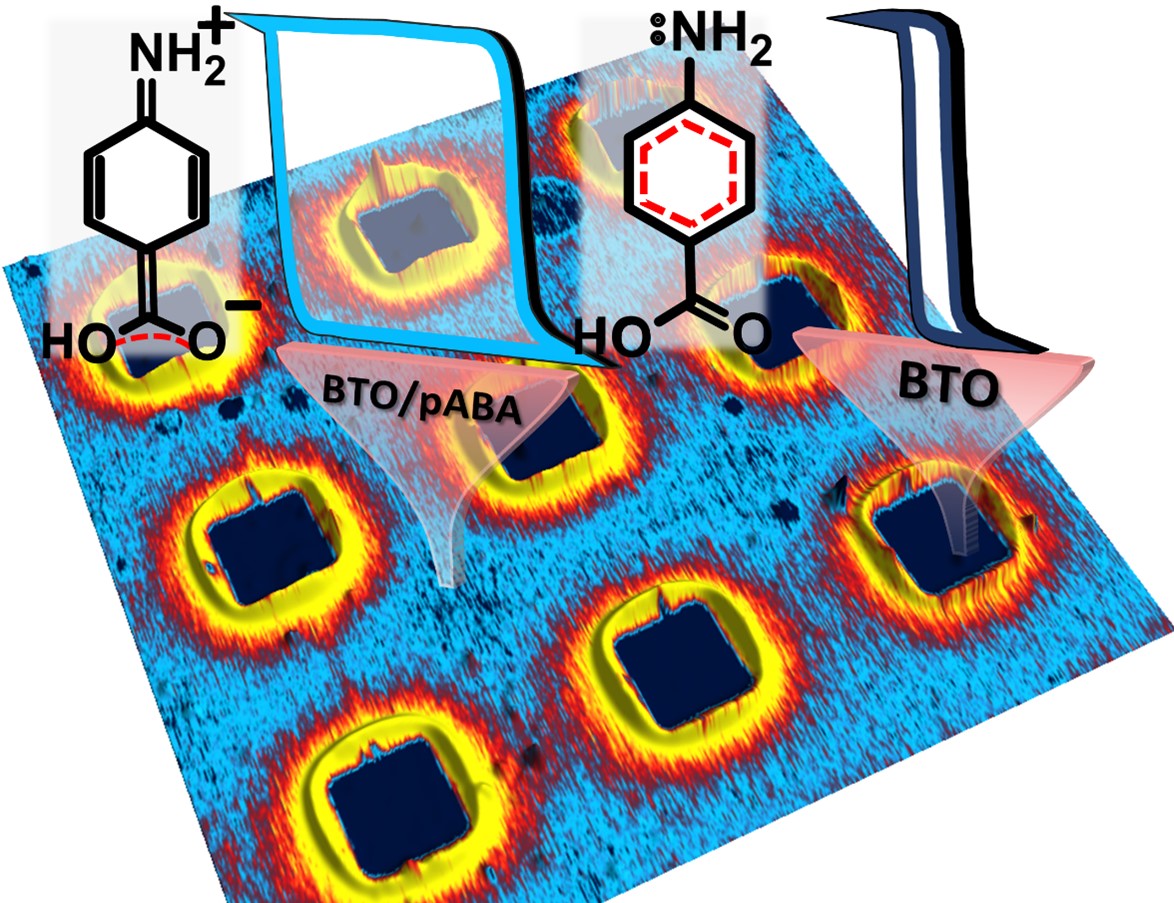Thursday, 20 April 2023
Tunable “chemical electrodes” for bistable polarization screening and control
Researchers at the ICN2 have devised a new method to control the polarization of ferroelectric surfaces by functionalising them with “optimal” organic molecules, whose internal electronic configuration adapts to polarization orientation upon switching. These "chemical electrodes" have proven to be more efficient than standard metallic electrodes or atmospheric adsorbates used up to now.

The switchable spontaneous polarization of ferroelectric materials makes them very interesting for technological applications. They are largely used in electronics and information technology as capacitors, ultrasonic transducers, thermistors, optoelectronic devices, and piezoelectric sensors. However, controlling the ferroelectric polarization of thin films at the nanoscale level can be challenging due to polar discontinuities at interfaces and surfaces and the presence of depolarizing fields.
In order to mitigate such undesired effects, various methods for screening the depolarizing field can be put in place. In capacitors, it is done by the electrodes, while in bare ferroelectric surfaces, it is typically accomplished by atmospheric adsorbates. Although the latter are effective in stabilizing the ferroelectric polarization at surfaces, they are not optimal for screening since their composition and adsorption are difficult to control and predict, and dominant charged species can favour one polarity over the opposite, requiring the dipole rotation and change of the interfacial chemical bond upon switching.
To address these limitations, a new screening concept has been proposed by researchers from the ICN2 Oxide Nanophysics Group (led by Prof. Gustau Catalán) and the ICN2 Nanomaterials Growth Unit (led by Dr José Santiso), in collaboration with Prof. Neus Domingo (former Head of the ICN2 Advanced AFM Platform). As explained in a paper recently published in the journal Small, the authors fabricated “chemical electrodes” by surface functionalization of ferroelectric thin films with resonance-stabilized molecules.
Ferroelectric surfaces are modified using specific molecules that are able to provide efficient electrical screening of depolarization fields and that can also adapt to the change in screening needs when the polarization is switched. Therefore, these chemical electrodes combine the predictability and bipolarity of conventional metallic electrodes with the screening efficiency of adsorbates.
“The breakthrough innovation in this work is the use of organic molecules, specifically para-aminobenzoic acid (pABA), which present resonant electronic structures,” explains Dr Irena Spasojevic, first and corresponding author of the paper. “This means that the electrons can internally relocate within pABA molecules and adopt different configurations upon polarization switching, thus adapting to the screening needs of ferroelectric polarization without having to break any chemical bond.”
“As a further extension of the concept,” continues Dr Spasojevic, “we have intercalated pABA molecules between graphene and a ferroelectric thin film, showing that such hybrid capacitors preserve the superior screening ability of pABA.” In this way, the authors not only demonstrated that chemical electrodes present various advantages over conventional metallic ones, but also that these structures can be laid one on top of the other and therefore their properties combined.
The introduction of chemical electrodes based on resonance-stabilized molecules can strongly improve the engineering of nanodevices, such as ferroelectric tunnel junctions, where stability of ferroelectric polarization in ultra-thin films is key to device performance. In addition, this research is likely to inspire similar studies using different material combinations.
Reference article:
Irena Spasojevic, José Santiso, José Manuel Caicedo, Gustau Catalán and Neus Domingo, Tunable chemical electrodes for bistable polarization screening. Small, April 2023. DOI: 10.1002/smll.202207799

